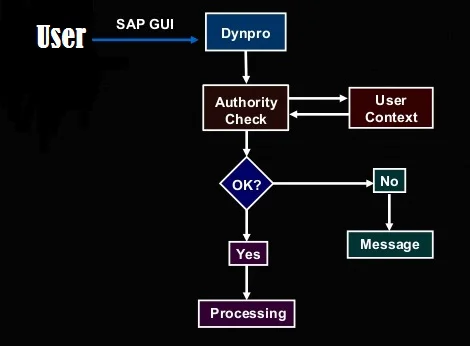AUTHORITY-CHECK (ABAP Keyword) introduction & Details
AUTHORITY-CHECK
Basic form
AUTHORITY-CHECK OBJECT object
ID name1 FIELD f1
ID name2 FIELD
f2
…
ID name10 FIELD f10.
Effect
Explanation of IDs:
object Field which contains the name of the object for which the authorization is to be checked.
name1 … Fields which contain the names of the name10 authorization fields defined in the object.
f1 … Fields which contain the values for which the f10 authorization is to be checked.
AUTHORITY-CHECK checks for one object whether the user has an authorization that contains all values of f (see SAP authorization concept). You must specify all authorizations for an object and a also a value for each ID (or DUMMY ). The system checks the values for the ID s by AND-ing them together, i.e. all values must be part of an authorization assigned to the user.
If a user has several authorizations for an object, the values are OR-ed together. This means that if the CHECK finds all the specified values in one authorization, the user can proceed. Only if none of the authorizations for a user contains all the required values is the user rejected. If the return code SY-SUBRC = 0, the user has the required authorization and may continue.
The return code is modified to suit the different error scenarios. The return code values have the following meaning:
- 4 : User has no authorization in the SAP System for such an action. If necessary, change the user master record.
- 8 : Too many parameters (fields, values). Maximum allowed is 10.
- 12 : Specified object not maintained in the user master record.
- 16 : No profile entered in the user master record.
- 24 : The field names of the check call do not match those of an authorization. Either the authorization or the call is incorrect.
- 28 : Incorrect structure for user master record.
- 32 : Incorrect structure for user master record.
- 36 : Incorrect structure for user master record.
If the return code value is 8 or possibly 24, inform the person responsible for the program. If the return code value is 4, 12, 15 or 24, consult your system administrator if you think you should have the relevant authorization. In the case of errors 28 to 36, contact SAP, since authorizations have probably been destroyed. Individual authorizations are assigned to users in their respective user profiles, i.e. they are grouped together in profiles which are stored in the user master record.
Note
Instead of ID name FIELD f , you can also write ID name DUMMY . This means that no check is performed for the field concerned. The check can only be performed on CHAR fields. All other field types result in ‘unauthorized’.
Example
Check whether the user is authorized for a particular plant. In this case, the following authorization object applies:
Table OBJ : Definition of authorization
object
M_EINF_WRK
ACTVT
WERKS
Here, M_EINF_WRK is the object name, whilst ACTVT and WERKS are authorization fields. For example, a user with the authorizations
M_EINF_WRK_BERECH1
ACTVT 01-03
WERKS 0001-0003
.
can display and change plants within the Purchasing and Materials Management areas.
Such a user would thus pass the checks
AUTHORITY-CHECK OBJECT ‘M_EINF_WRK’
ID ‘WERKS’ FIELD
‘0002’
ID ‘ACTVT’ FIELD ’02’.
AUTHORITY-CHECK OBJECT
‘M_EINF_WRK’
ID ‘WERKS’ DUMMY
ID ‘ACTVT’ FIELD ’01’:
but would fail the check
AUTHORITY-CHECK OBJECT ‘M_EINF_WRK’
ID ‘WERKS’
FIELD ‘0005’
ID ‘ACTVT’ FIELD ’04’.
To suppress unnecessary authorization checks or to carry out checks before the user has entered all the values, use DUMMY – as in this example. You can confirm the authorization later with another AUTHORITY-CHECK in ABAP .
See the process flow of a program with SAP authority check from the below image.
Some Basic Questions & Answers
Transaction code SU53 is used for getting the details about last authorization check for a user. See tcode SU53 details
We will get the return code 40 for an invalid user ID.
